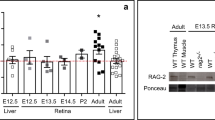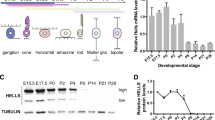Abstract
The activating E2f transcription factors (E2f1, E2f2 and E2f3) induce transcription and are widely viewed as essential positive cell cycle regulators. Indeed, they drive cells out of quiescence, and the ‘cancer cell cycle’ in Rb1 null cells is E2f-dependent1,2. Absence of activating E2fs in flies or mammalian fibroblasts causes cell cycle arrest3,4, but this block is alleviated by removing repressive E2f or the tumour suppressor p53, respectively5,6,7. Thus, whether activating E2fs are indispensable for normal division is an area of debate1. Activating E2fs are also well known pro-apoptotic factors, providing a defence against oncogenesis8, yet E2f1 can limit irradiation-induced apoptosis9,10. In flies this occurs through repression of hid (also called Wrinkled; Smac/Diablo in mammals). However, in mammals the mechanism is unclear because Smac/Diablo is induced, not repressed, by E2f111, and in keratinocytes survival is promoted indirectly through induction of DNA repair targets12. Thus, a direct pro-survival function for E2f1–3 and/or its relevance beyond irradiation has not been established. To address E2f1–3 function in normal cells in vivo we focused on the mouse retina, which is a relatively simple central nervous system component that can be manipulated genetically without compromising viability and has provided considerable insight into development and cancer2,13. Here we show that unlike fibroblasts, E2f1–3 null retinal progenitor cells or activated Müller glia can divide. We attribute this effect to functional interchangeability with Mycn. However, loss of activating E2fs caused downregulation of the p53 deacetylase Sirt1, p53 hyperacetylation and elevated apoptosis, establishing a novel E2f–Sirt1–p53 survival axis in vivo. Thus, activating E2fs are not universally required for normal mammalian cell division, but have an unexpected pro-survival role in development.
This is a preview of subscription content, access via your institution
Access options
Subscribe to this journal
Receive 51 print issues and online access
$199.00 per year
only $3.90 per issue
Buy this article
- Purchase on Springer Link
- Instant access to full article PDF
Prices may be subject to local taxes which are calculated during checkout




Similar content being viewed by others
References
Rowland, B. D. & Bernards, R. Re-evaluating cell-cycle regulation by E2Fs. Cell 127, 871–874 (2006)
Pacal, M. & Bremner, R. Insights from animal models on the origins and progression of retinoblastoma. Curr. Mol. Med. 6, 759–781 (2006)
van den Heuvel, S. & Dyson, N. J. Conserved functions of the pRB and E2F families. Nature Rev. Mol. Cell Biol. 9, 713–724 (2008)
Wu, L. et al. The E2F1–3 transcription factors are essential for cellular proliferation. Nature 414, 457–462 (2001)
Timmers, C. et al. E2f1, E2f2, and E2f3 control E2F target expression and cellular proliferation via a p53-dependent negative feedback loop. Mol. Cell. Biol. 27, 65–78 (2007)
Sharma, N. et al. Control of the p53-p21CIP1 axis by E2f1, E2f2, and E2f3 is essential for G1/S progression and cellular transformation. J. Biol. Chem. 281, 36124–36131 (2006)
Frolov, M. V. et al. Functional antagonism between E2F family members. Genes Dev. 15, 2146–2160 (2001)
Iaquinta, P. J. & Lees, J. A. Life and death decisions by the E2F transcription factors. Curr. Opin. Cell Biol. 19, 649–657 (2007)
Moon, N. S. et al. Drosophila E2F1 has context-specific pro- and antiapoptotic properties during development. Dev. Cell 9, 463–475 (2005)
Wikonkal, N. M. et al. Inactivating E2f1 reverts apoptosis resistance and cancer sensitivity in Trp53-deficient mice. Nature Cell Biol. 5, 655–660 (2003)
Xie, W. et al. Novel link between E2F1 and Smac/DIABLO: proapoptotic Smac/DIABLO is transcriptionally upregulated by E2F1. Nucleic Acids Res. 34, 2046–2055 (2006)
Berton, T. R., Mitchell, D. L., Guo, R. & Johnson, D. G. Regulation of epidermal apoptosis and DNA repair by E2F1 in response to ultraviolet B radiation. Oncogene 24, 2449–2460 (2005)
Livesey, F. J. & Cepko, C. L. Vertebrate neural cell-fate determination: lessons from the retina. Nature Rev. Neurosci. 2, 109–118 (2001)
Chen, D. et al. Rb-mediated neuronal differentiation through cell-cycle-independent regulation of E2f3a. PLoS Biol. 5, e179 (2007)
Dyer, M. A. & Cepko, C. L. Control of Muller glial cell proliferation and activation following retinal injury. Nature Neurosci. 3, 873–880 (2000)
Claassen, G. F. & Hann, S. R. A role for transcriptional repression of p21CIP1 by c-Myc in overcoming transforming growth factor β-induced cell-cycle arrest. Proc. Natl Acad. Sci. USA 97, 9498–9503 (2000)
Alevizopoulos, K., Vlach, J., Hennecke, S. & Amati, B. Cyclin E and c-Myc promote cell proliferation in the presence of p16INK4a and of hypophosphorylated retinoblastoma family proteins. EMBO J. 16, 5322–5333 (1997)
Santoni-Rugiu, E., Falck, J., Mailand, N., Bartek, J. & Lukas, J. Involvement of Myc activity in a G1/S-promoting mechanism parallel to the pRb/E2F pathway. Mol. Cell. Biol. 20, 3497–3509 (2000)
DeGregori, J. & Johnson, D. G. Distinct and overlapping roles for E2F family members in transcription, proliferation and apoptosis. Curr. Mol. Med. 6, 739–748 (2006)
Chen, D., Padiernos, E., Ding, F., Lossos, I. S. & Lopez, C. D. Apoptosis-stimulating protein of p53–2 (ASPP2/53BP2L) is an E2F target gene. Cell Death Differ. 12, 358–368 (2005)
Fogal, V. et al. ASPP1 and ASPP2 are new transcriptional targets of E2F. Cell Death Differ. 12, 369–376 (2005)
Aslanian, A., Iaquinta, P. J., Verona, R. & Lees, J. A. Repression of the Arf tumor suppressor by E2F3 is required for normal cell cycle kinetics. Genes Dev. 18, 1413–1422 (2004)
Bode, A. M. & Dong, Z. Post-translational modification of p53 in tumorigenesis. Nature Rev. Cancer 4, 793–805 (2004)
Tang, Y., Zhao, W., Chen, Y., Zhao, Y. & Gu, W. Acetylation is indispensable for p53 activation. Cell 133, 612–626 (2008)
Wang, C. et al. Interactions between E2F1 and SirT1 regulate apoptotic response to DNA damage. Nature Cell Biol. 8, 1025–1031 (2006)
Malumbres, M. & Barbacid, M. Cell cycle, CDKs and cancer: a changing paradigm. Nature Rev. Cancer 9, 153–166 (2009)
Livne-bar, I. et al. Chx10 is required to block photoreceptor differentiation but is dispensable for progenitor proliferation in the postnatal retina. Proc. Natl Acad. Sci. USA 103, 4988–4993 (2006)
Chen, D. et al. Cell-specific effects of RB or RB/p107 loss on retinal development implicate an intrinsically death-resistant cell-of-origin in retinoblastoma. Cancer Cell 5, 539–551 (2004)
Vaziri, H. et al. hSIR2(SIRT1) functions as an NAD-dependent p53 deacetylase. Cell 107, 149–159 (2001)
Marquardt, T. et al. Pax6 is required for the multipotent state of retinal progenitor cells. Cell 105, 43–55 (2001)
Soriano, P. Generalized lacZ expression with the ROSA26 Cre reporter strain. Nature Genet. 21, 70–71 (1999)
Leone, G. et al. Myc requires distinct E2F activities to induce S phase and apoptosis. Mol. Cell 8, 105–113 (2001)
Jonkers, J. et al. Synergistic tumor suppressor activity of BRCA2 and p53 in a conditional mouse model for breast cancer. Nature Genet. 29, 418–425 (2001)
Knoepfler, P. S., Cheng, P. F. & Eisenman, R. N. N-myc is essential during neurogenesis for the rapid expansion of progenitor cell populations and the inhibition of neuronal differentiation. Genes Dev. 16, 2699–2712 (2002)
Bracken, A. P., Ciro, M., Cocito, A. & Helin, K. E2F target genes: unraveling the biology. Trends Biochem. Sci. 29, 409–417 (2004)
Xu, X. et al. A comprehensive ChIP-chip analysis of E2F1, E2F4, and E2F6 in normal and tumor cells reveals interchangeable roles of E2F family members. Genome Res. 17, 1550–1561 (2007)
Ozono, E. et al. E2F-like elements in p27(Kip1) promoter specifically sense deregulated E2F activity. Genes Cells 14, 89–99 (2009)
Weinmann, A. S., Bartley, S. M., Zhang, T., Zhang, M. Q. & Farnham, P. J. Use of chromatin immunoprecipitation to clone novel E2F target promoters. Mol. Cell. Biol. 21, 6820–6832 (2001)
Weinmann, A. S., Yan, P. S., Oberley, M. J., Huang, T. H. & Farnham, P. J. Isolating human transcription factor targets by coupling chromatin immunoprecipitation and CpG island microarray analysis. Genes Dev. 16, 235–244 (2002)
Christensen, J. et al. Characterization of E2F8, a novel E2F-like cell-cycle regulated repressor of E2F-activated transcription. Nucleic Acids Res. 33, 5458–5470 (2005)
Lyons, T. E., Salih, M. & Tuana, B. S. Activating E2Fs mediate transcriptional regulation of human E2F6 repressor. Am. J. Physiol. Cell Physiol. 290, C189–C199 (2006)
Mao, D. Y. et al. Analysis of Myc bound loci identified by CpG island arrays shows that Max is essential for Myc-dependent repression. Curr. Biol. 13, 882–886 (2003)
Bieda, M., Xu, X., Singer, M. A., Green, R. & Farnham, P. J. Unbiased location analysis of E2F1-binding sites suggests a widespread role for E2F1 in the human genome. Genome Res. 16, 595–605 (2006)
Kim, J., Chu, J., Shen, X., Wang, J. & Orkin, S. H. An extended transcriptional network for pluripotency of embryonic stem cells. Cell 132, 1049–1061 (2008)
Zeller, K. I. et al. Global mapping of c-Myc binding sites and target gene networks in human B cells. Proc. Natl Acad. Sci. USA 103, 17834–17839 (2006)
Zeller, K. I., Jegga, A. G., Aronow, B. J., O’Donnell, K. A. & Dang, C. V. An integrated database of genes responsive to the Myc oncogenic transcription factor: identification of direct genomic targets. Genome Biol. 4, R69 (2003)
Acknowledgements
We thank L. van Parijs and R. Weinberg for plasmids; R. Eisenman for mice; L. Penn for advice on Myc; and M. Cayouette and J. Wrana for comments. This work was supported by a grant from the Canadian Institutes for Health Research to R.B. (MOP-74570).
Author Contributions D.C. and R.B. designed the study and interpreted data. D.C. performed all the experiments and was aided in viral and electroporation assays by M.P. P.W., G.L. and P.S.K. provided reagents including mice. R.B. wrote the paper and all authors contributed to editing.
Author information
Authors and Affiliations
Corresponding author
Supplementary information
Supplementary Information
This file contains a Supplementary Discussion, Supplementary References, Supplementary Table 1 and Supplementary Figures 1-13 with Legends. (PDF 1709 kb)
Rights and permissions
About this article
Cite this article
Chen, D., Pacal, M., Wenzel, P. et al. Division and apoptosis of E2f-deficient retinal progenitors. Nature 462, 925–929 (2009). https://doi.org/10.1038/nature08544
Received:
Accepted:
Issue Date:
DOI: https://doi.org/10.1038/nature08544
This article is cited by
-
Adiponectin in psoriasis and its comorbidities: a review
Lipids in Health and Disease (2021)
-
Preclinical studies reveal MLN4924 is a promising new retinoblastoma therapy
Cell Death Discovery (2020)
-
Chromatin remodeling protein HELLS is critical for retinoblastoma tumor initiation and progression
Oncogenesis (2020)
-
Functional genomics identifies new synergistic therapies for retinoblastoma
Oncogene (2020)
-
The broken cycle: E2F dysfunction in cancer
Nature Reviews Cancer (2019)
Comments
By submitting a comment you agree to abide by our Terms and Community Guidelines. If you find something abusive or that does not comply with our terms or guidelines please flag it as inappropriate.



